From Telegraphy to GMDSS
In 1887/1888 the German physicist Heinrich Hertz managed to generate electromagnetic waves and discovered that an intermittent electric discharge across a spark gap produces radio frequency which can be transmitted and received. This was the birth of radio technology.
The Russian Alexander S. Popov, designed a radio wave receiver that could be used as a lightning detector, to warn of thunderstorms by detecting the electromagnetic pulses of lightning strikes. This was the birth of the receiving antenna in 1895.
In a demonstration in 1896, he used radio waves to transmit a message between different campus buildings.
Further, the French explorer Eduard Branly is one of the pioneers of wireless telegraphy. He improved the Hertzian Receiver to a so-called ‘coherer’, which, simply spoken, could indicate electromagnetic waves (1890). This device was used to drive a Morse undulator.
The American Samuel Morse developed the first operational morse telegraph that wrote marks on moving paper tape. Later, his assistant Alfred Vail developed a drawing system with dots and dashes. This Morse code was introduced in 1838-44 as the telegraphic code. It was used worldwide in telegraphy via cable, wireless radiotelegraphy and also with light signals with spotlights.
The Italian Guglielmo Marconi started in 1895 with his experiments in radio telegraphy, which he successfully continued in England from 1896. He connected the spark generator with a wire and had thus built the first transmitting antenna. In 1897 he succeeded the first wireless radio transmission over 14.5 km across the Bristol Channel. In the same year he began to convert various optical signal points on the English coast into coastal radio stations. In 1901 he managed to bridge the North Atlantic with wireless radio telegraphy.
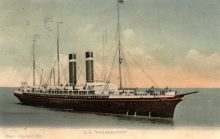
Marconi was not an inventor, but a practitioner. He used existing techniques, developed them, and patented them (for example, the Hertz transmitter, the Popov antenna, and the coherer from Branly). He was very business-minded and founded his own company for the marketing of the radio devices.
In 1898 Marconi has made a connection from the lighthouse ‘South Foreland’ to the lightship ‘East Goodwin’. In 1899 he had bridged the English channel in radio telegraphy. In 1901, the first radio communications across the Atlantic was exchanged between Poldhu Station in England and St. John’s in Newfoundland, North America. One year later, ship to shore experiments from the steamer ‘Philadelphia’ to Poldhu followed.
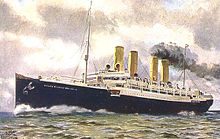
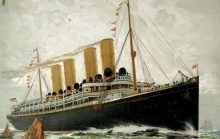
The first German ship fitted with a Marconi radio station was the SS ‘Kaiser Wilhelm der Große’ from the Norddeutscher Lloyd (NDL) built 1903. The company Hapag followed in 1901 with the fast steamer ‘Deutschland’.
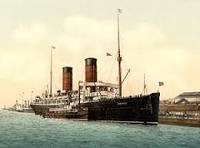
The steamship’Campania’, owned by Cunard Shipping Company, was one of the first British ships with a radio station on board. During a voyage to New York in1905, the ship had a constant radio connection to land stations in Europe and America, which meant a ship on the ocean could be reached at any time and was able to report from ship to shore.
Especially in the case of accidents, the wireless radio telegraphy between ships and from ship to shore and v.v. hit the headlines in the press.
The courageous radio officers were celebrated, the radio telegraphy was praised.
When in 1899 the Russian battleship ‘General Admiral Apraksin’ was stuck in the ice in the Finnish Gulf, Popov’s radio link between Gotland and Kotka was used. With the assistance of the requested icebreaker ‘Yermak’ the ship and all persons were rescued.
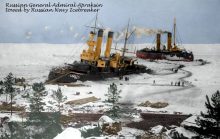
In 1910, for the first time ever, a criminal case was solved with the help of wireless telegraphy. The English doctor Crippen had killed his wife and hastily buried her in the basement of his own house. Together with his girlfriend, who was disguised as a man, he fled on the Canadian steamer ‘Montrose’ across the Atlantic. But the captain got suspicious and sent a radio message to England. A Scotland Yard inspector followed the ‘Montrose’ with the faster RMS ‘Laurentic’. The ‘Laurentic’ caught up with the ‘Montrose’ off the Canadian coast. In Montreal Dr. Crippen disembarked handcuffed. Later he was sentenced to death. His girlfriend was acquitted.
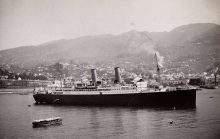
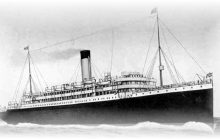
In April 1912, the White Star liner ‘Titanic’ collided with an iceberg and sank in the North Atlantic. The radio officer of the ‘Titanic’ sent ‘CQD’ and ‘SOS’ calls which were heard from the steamer ‘Carpathia’. The ‘Carpathia’ hurried to the scene of accident and was able to rescue 712 people.
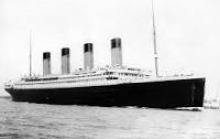
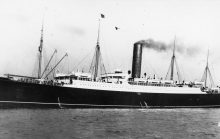
On board the bulk carrier ‘Californian’ the radio officer slept. The ship past in a distance of 5 to 8 nautical miles.
One could say that this accident lead to the introduction of the Auto Alarm Device. Around 1,500 people died in the freezing waters. The radio operators at the Marconi Radio Stations were not allowed to receive telegrams from non- Marconi stations. This led to an enlarged installation of Ship- and Coastal Radio Stations made by Telefunken. A hard battle for market share arose. Endless patent litigation between the Marconi Company and Telefunken were the result.
In 1911 the DEBEG was founded, a German company for servicing radio stations. Under the roof of the DEBEG the competition was ended in 1914. Through licensing agreements, DEBEG supervised both, the Marconi and the Telefunken radio stations.
Since 1904 the Marconi radio operators were obliged to use the distress signal CQD.
CQD is understood by radio operators to mean, ‘All stations distress’. Much later, this signal has been interpreted as ‘Come Quick Danger’.
Due to the high competition between the manufacturers Marconi and Telefunken, Marconi radio operators were not allowed to accept radio- and even emergency calls from ships with the other system!
At the International Radio Conference in Berlin in 1906, the distress signal of three-dots/three-dashes/three-dots was considered to be the international distress signal. This distress signal soon became known as ‘SOS’, interpreted as ‘Save our Soul’ or ‘Save our Ship’.
For radio telephony the distress signal MAYDAY became effective.
Marconi’s commercial interest was the distribution of his equipment. He especially focused on the respective Navies. The British fleet was the first exclusively equipped with Marconi plants, while the German Imperial Navy first made attempts, but then decided for the Telefunken plants which were available on the market meanwhile.
Already at that time it was about the price. Therefore, the Imperial Austrian Navy also decided for the Telefunken equipment as “Marconi’s devices were overprized”.
The education of the radio personnel took place in own telecommunications schools. The places were highly coveted because of the possibility of deployment on a warship and a life on bord.
Some applications of marine radio:
Sending the time signal from the Greenwich null meridian to tune the on-board chronometer. The Greenwich time is required for the calculation of the meridian length.
Worldwide weather service in plain text and with weather charts, warning messages, e.g. ice reporting service
Telegrams, telexes, radio calls for passengers and crew.
Notices for Mariners, information and changes in trade lanes
Board newspaper, short version of news of a country newspaper, e.g. the Times or the Hamburger Abendblatt.
Medical advice ‘Medico’ at sea, especially for ships without a doctor.
Position determination via radio direction finder, consol, decca, LORAN (long range), omega, transit/GPS (Global Position System via satellite).
Collision protection via RADAR (Radio Detecting and Ranging).
AMVER (Automated Mutual Assistance Vessel Rescue), reporting service of the US Coast Guard; i.e. every ship crossing an ocean registers with the US Coast Guard, which monitors the passage and initiates assistance if necessary.
Some further data:
From 1914 development of the tube transmitter, which then spread after the First World War
In the 20’s beginning of shortwave radio, the Heavyside layer in the stratosphere reflects the shortwave. Improvements in radiotelephony.
1925 worldwide 115,000 radio stations on ships and on land.
In 1934 the ships received new callsigns, the first two places indicate nationality.
From the 50s ultra-shortwave (FM) in use, voice, channel 16 (156.800 MHz) will be call channel.
Starting from 1965 Radio Telex, Telex and Fax devices for weather maps
from 1971 the distress radio beacon EPIRB (emergency Position Indicating Radio Beacon) is used on both 2182 kHz and later as satellite-EPIRB.
Satellites terminate the traditional radio service:
In 1976, a serviceable satellite system for the marine radio was presented.
Since 1979, the INMARSAT (International MARITIME SATellite Organization) has been working, in which almost all shipping nations are members. With this system you no longer need a radio officer, the message exchange goes via satellite to all possible data reception equipment such as telephone, telex, modem, etc. …
Since 1991, the satellite distress system GMDSS (Global Maritime Distress and Safety System) is in use. The ship’s officer can report a distress at the push of a button. The classic distress radio traffic initiated by ‘SOS’, is dropped.
Since 1.2.1999 GMDSS is mandatory for all seagoing vessels.
In the mid-90s, the coastal radio stations, in Germany i.e. Kiel Radio / DAO, Norddeich Rradio / DAN, Rügen Radio / DHS were dissolved. You do not need an exchange for maritime radio traffic any more, you do not need Morse code anymore.
The job description of the radio officer is history.
